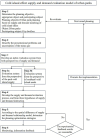Evaluation of the cold island effect of the urban parks in the main urban area of Wuhan from the perspective of supply and demand
- PMID: 40165981
- PMCID: PMC11955679
- DOI: 10.3389/fpubh.2025.1523210
Evaluation of the cold island effect of the urban parks in the main urban area of Wuhan from the perspective of supply and demand
Abstract
Background: Rapid urbanization has led to a series of "urban diseases" that have garnered significant social attention. Among these, the urban heat island effect has emerged as one of the most pronounced environmental concerns, presenting formidable challenges for urban planning in terms of sustainable development and environmental livability. In this process, the construction of urban parks is particularly susceptible to discrepancies between supply and demand.
Methods: In this study, urban parks with an area of more than 3hm2 in the main urban area of Wuhan were selected as research objects. Utilizing remote sensing data and urban vector data, this study applied kernel density analysis and Thiessen polygons development to assess the supply capacity of parks' cold islands from a supply perspective, and the residents' cold island demand level index from a demand perspective.
Results: The findings revealed that ① The spatial distribution of cold island supply and demand exhibited significant heterogeneity. High-supply units were strongly correlated with water body distribution, while high-demand units aligned closely with population density and POI density centers, displaying a "scattered overall, locally concentrated" pattern. ② A significant supply-demand mismatch in cold island effects was observed, with 19 units (accounting for approximately 40%) exhibiting insufficient supply relative to demand. These units were predominantly concentrated in areas with complex building environments, high population density, low vegetation coverage, and poor landscape connectivity.
Discussion and conclusions: Drawing on these results, the study established an interplay between supply and demand perspectives by applying the theory of locational entropy and proposed optimization strategy for urban parks in Wuhan, aiming to achieve "a match between supply and demand in cold islands" across varying equilibrium stages of the research units. Specific measures include: optimizing the scale and layout of existing parks, reserving green spaces for ecological restoration, strengthening the protection of blue-green ecological foundations, and establishing a blue-green cold island corridor network to enhance ecological connectivity. Our work extends the understanding of the cold island effect of urban parks, assisting urban planners in proposing more targeted and effective management strategy and measures to improve the urban thermal environment, thereby contributing to the creation of healthy, equitable, and sustainable cities.
Keywords: cold island effect; planning strategy; supply and demand evaluation; urban heat and cold islands; urban parks.
Copyright © 2025 Song, Qiao and Liu.
Conflict of interest statement
The authors declare that the research was conducted in the absence of any commercial or financial relationships that could be construed as a potential conflict of interest.
Figures















References
-
- Amani-Beni M, Zhang B, Xie GD, Xu J. Impact of Urban Park’s tree, grass and waterbody on microclimate in hot summer days: a case study of Olympic Park in Beijing, China. Urban For Urban Green. (2018) 32:1–6. doi: 10.1016/j.ufug.2018.03.016 - DOI
MeSH terms
LinkOut - more resources
Full Text Sources

